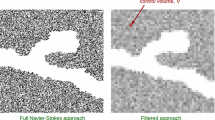Abstract
Simulation of coupled chemical reactions and fluid flow in porous sedimentary basins over long time periods is a numerical challenge. Most models representing such a physical problem are solved as PDEs where efficient timestepping with controlled error is difficult. We use the differential algebraic equation system approach where robust adaptive timestepping algorithms are available in the solvers, e.g., RADAU5 and DASSL. Mathematical and numerical models for coupled chemical reactions and fluid flow are derived. The models have several interesting properties, e.g., strong nonlinearities and stiffness, which are discussed. We test the performance of our code.
Similar content being viewed by others
References
C.M. Bethke, Geochemical Reaction Modelling - Concepts and Applications (Oxford University Press, Oxford, 1996).
K.E. Brenan, S.L. Campbell and L.R. Petzold, Numerical Solution of Initial-Value Problems in Differential-Algebraic Equations (Elsevier, Amsterdam, 1989).
G. Dahlquist, L. Edsberg, G. Sköllermo and G. Söderlind, Are the numerical methods and software satisfactory for chemical kinetics?, in: Numerical Integration of Differential Equations and Large Linear Systems: Proc. Bielefeld, ed. J. Hinze, Lecture Notes in Mathematics 968 (Springer, Berlin, 1980) pp. 149-164.
R.W. Freund, A transpose-free quasi-minimal residual algorithm for non-Hermitian linear systems, SIAM J. Sci. Comput. 14 (1993) 470-482.
R.M. Garrels and M.E. Thompson, A chemical model for sea water at 25°C and one atmosphere total pressure, Amer. J. Sci. 260 (1962) 57-66.
E. Hairer and G. Wanner, Solving Ordinary Differential Equations II, Stiff and Differential-Algebraic Problems (Springer, Berlin, 1991).
H.C. Helgeson, Evaluation of irreversible reactions in geochemical processes involving minerals and aqueous solutions, I. Thermodynamic relations, Geochim. Cosmochim. Acta 32 (1968) 853-877.
P.C. Lichtner, Continuum model for simultaneous chemical reactions and mass transport in hydrothermal systems, Geochim. Cosmochim. Acta 49 (1985) 779-800.
P.C. Lichtner, The quasi-stationary state approximation to coupled mass transport and fluid-rock interaction in a porous media, Geochim. Cosmochim. Acta 52 (1988) 143-165.
P.C. Lichtner, The quasi-stationary state approximation to fluid/rock reaction: Local equilibrium revisited, in: Diffusion, Atomic Ordering, and Mass Transport, ed. J. Gangly, Adv. Phys. Geochem. 8 (Springer, Berlin, 1991) pp. 453-559.
D.C. Mangold and C.-F. Tsang, A summary of subsurface hydrological and hydrochemical models, Rev. Geophys. 29 (1991) 51-79.
P.J. Ortoleva, Geochemical Self-Organization (Oxford University Press, Oxford, 1994).
P. Ortoleva, J. Chadam, E. Merino and A. Sen, Geochemical self-organization, II. The reactive-infiltration instability, Amer. J. Sci. 287 (1987) 1008-1040.
P. Ortoleva, E. Merino, C. Moore and J. Chadam, Geochemical self-organization, I. Reaction-transport feedbacks and modeling approach, Amer. J. Sci. 287 (1987) 979-1007.
C.I. Steefel and A.C. Lasaga, Evolution of dissolution patterns: Permeability change due to coupled flow and reaction, Chemical Modelling of Aqueous Systems II, eds. D.C. Melchior and R.L. Bassett, ACS Symp. series 416 (1990) pp. 212-225.
C.I. Steefel and A.C. Lasaga, Putting transport into water-rock interaction models, Geology 20 (1992) 680-684.
C.I. Steefel and A.C. Lasaga, A coupled model for transport of multiple chemical species and kinetic precipitation/dissolution reactions with application to reactive flow in single phase hydrothermal systems, Amer. J. Sci. 294 (1994) 529-592.
J.G. Verwer and M. van Loon, An evaluation of explicit pseudo-steady-state approximation schemes for stiff ODE systems from chemical kinetics, J. Comput. Phys. 113 (1994) 347-352.
G.T. Yeh and V.S. Tripathi, A critical evaluation of recent developments in hydrogeochemical transport models of reactive multichemical components, Water Resources Res. 25 (1989) 93-108.
G.T. Yeh and V.S. Tripathi, A model for simulating transport of reactive multispecies components: Model development and demonstration, Water Resources Res. 27 (1991) 3075-3094.
Author information
Authors and Affiliations
Rights and permissions
About this article
Cite this article
Holstad, A. Modelling subsurface coupled chemical reactions and fluid flow over long time periods. Numerical Algorithms 19, 95–110 (1998). https://doi.org/10.1023/A:1019102406258
Issue Date:
DOI: https://doi.org/10.1023/A:1019102406258




